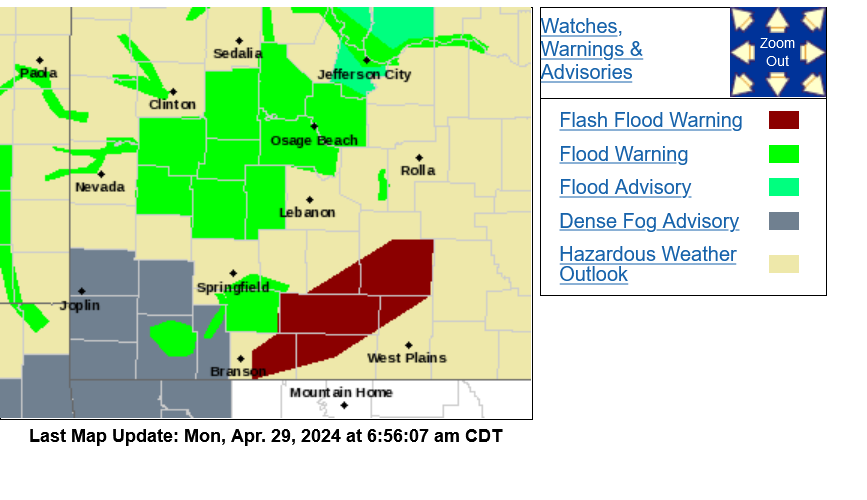
Storms this weekend included a tornado and major flooding in Bourbon County.
Because of almost 10 inches of rain, area rivers have gone out of their banks.
The Marmaton River crested at 47 feet on April 28, and is predicted to go back down to 30 feet by Tuesday afternoon, according to Peyton Camden, a meteorologist with the National Weather Service at Springfield, Mo, which monitors conditions in Bourbon, Cherokee, and Crawford Counties in Kansas.
Rain is in the forecast for the rest of the week.
“Depending on how much rain we get, there could be a second crest,” she said.
County roads and city streets in low-lying areas were flooded, but as of today, almost all are passable.
Tornado
A tornado touched down in rural Bourbon County on the evening of Friday, April 26.
“It touched down at about 85th and Poplar Roads on Friday evening,” Bourbon County Emergency Management Director Brian Allen said. One home near Quail Road was also affected, he said.
Clare George’s home, northeast of Uniontown, had the windows blown out on three sides and some roof damage, plus outbuildings damaged.
Flood damage
Brad Matkin, Fort Scott City Manager said most city streets are reopened following the floods this weekend.
“20th Street from Hwy. 69 to Cooper Street is still closed because of road destruction,” Matkin said on the city’s Facebook page. Clark Street from Wall Street to Third Street is still closed until the manhole flooding stops, and the Fort Scott Lake road by the spillway is still closed, he said. Fort Scott Lake homeowners can access via Hwy. 69 to Hackberry Road.
The city crews are out working to get things back to normal, Matkin said.
Eric Bailey, Bourbon County Public Works Director, referred road condition questions to Fort Scott/Bourbon County Dispatch.
The dispatcher said all roads in the county are open now, but people should be aware there is some damage to the roads.
Local Ponds Were Built to Help With Floods
Dams were built in the 1980s for helping to alleviate the excess water from floods.
Frank Young, the contracting officer for both the Marmaton and Mill Creek Watershed Districts, stated “the watershed dams aren’t constructed with the capacity to totally control runoff from extremely large rainfall events covering the drainage areas above each structure (pond). They will totally control the runoff from a 25 year storm which is around 4.8 inches of rainfall in a 6-hour period. The rest of the runoff from a larger rainfall event than 4.8 inches in 6 hours, will pass through the dam’s emergency spillway with some, but not total, control of that extra runoff”.
” Marmaton WSD has 28 completed structures that control roughly 25% of the total drainage area of the Marmaton River above Mill Creek. Mill Creel WSD has 14 completed dams that control roughly 28% of the Mill Creek drainage area. The two districts together control roughly 27% of the total drainage area above Ft. Scott,” Young said.
“When a huge rainfall event occurs over the entire river drainage area of just over 240,000 acres, over 70% of this area is uncontrolled,” he said. “The combined districts have plans to build structures that would control around a total of 60% of this area when completed.”
“Both Districts have planned structures awaiting permits to construct more dams from the Corps of Engineers,” Young said. Ever since Hurricane Katrina.. permits to construct dams have become increasingly difficult to obtain from these federal agencies. The last major dam construction ended for the Marmaton District in 2015. Since then no permits have been issued by the Corps to allow these Districts to continue their flood protection program.”
“The existing dams were constructed with state of Kansas grant money along with local cost share money raised from mill levies and landowner participation,” he said. “The districts both inspect their dams annually for damage caused by natural and or man-made events and conduct repairs and maintenance as needed to keep them in shape for service during flood events. The districts will again have to inspect the existing structures soon for damage caused by this flood with repairs, if needed, conducted throughout the coming months,” Young said.
Tetanus Shots For Flood/Tornado Workers
Brian Allen said he is working on getting tetanus vaccines from the State of Kansas for any workers who have worked in the flood waters that have inundated the county.
SEK Multi-County Health Department is offering free tetanus shots for individuals affected by the recent flooding. Tetanus shots will be available to impacted residents as well as first responders, volunteers, or any others who have been or will be assisting with recovery and cleanup efforts.
Free tetanus shots will be available by appointment at the SEK Multi-County Health Department in Iola, Garnett, and Fort Scott while flood response continues.
Bourbon County (Fort Scott): 524 S. Lowman, Fort Scott, KS 66701
Tetanus vaccines are recommended for people of all ages. Adults need a tetanus booster shot every 10 years, but health care providers may recommend a booster sooner due to an injury or other health concerns.
Tetanus bacteria are everywhere in the environment, including soil, dust, and manure. Tetanus is most commonly caused by the bacteria getting into the body through broken skin, usually through injuries from dirty objects. During evacuation and flood cleanup, residents affected by flooding, emergency responders, cleanup workers, or volunteers may be at increased risk for these injuries. For this reason, these people should be sure that they are up to date with tetanus vaccination. This can be done by talking with your health care provider or reviewing your vaccination record.
Tetanus is commonly known as “lockjaw,” and is a serious disease that affects the nervous system and causes painful muscle contractions, particularly of your jaw and neck muscles. Tetanus can cause severe breathing problems and in serious cases, lead to death. There is no cure for tetanus.
|